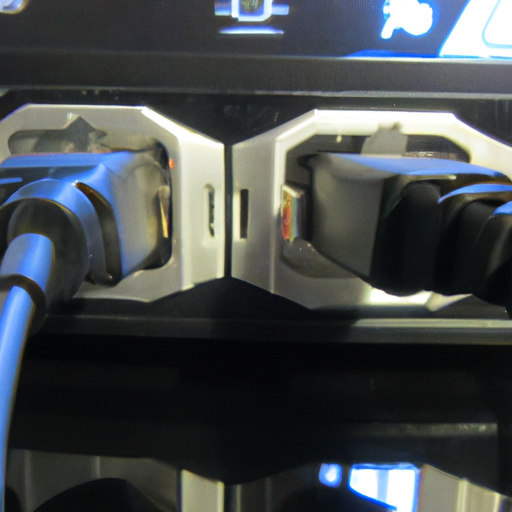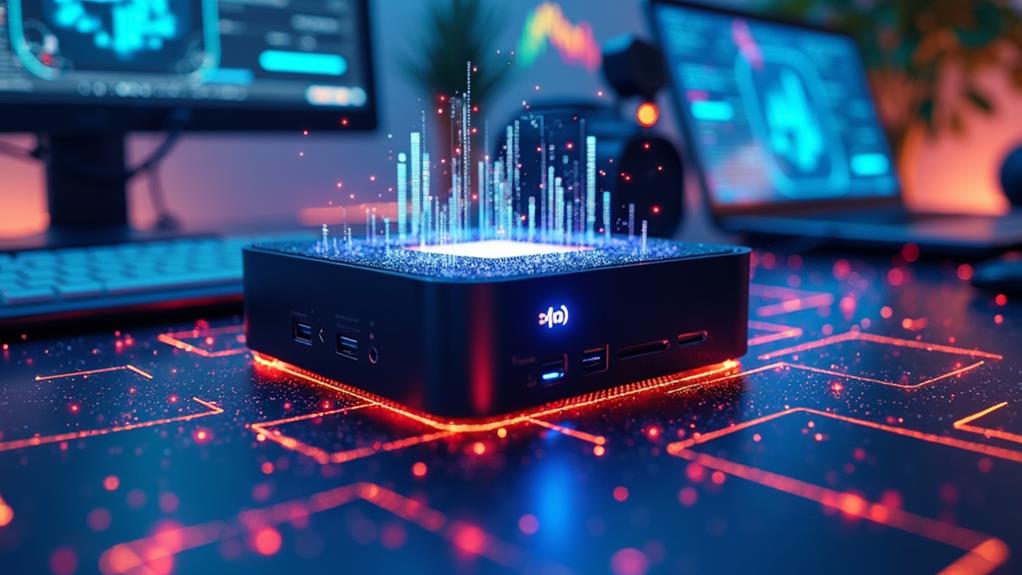



So you’ve got a mini PC and you want to take your media experience to the big screen? Look no further, because in this article, we’ve got you covered! If you’re wondering how to connect your mini PC to a TV, worry no more. We’ll walk you through the simple steps to make sure you’re all set up and ready to enjoy your favorite movies, shows, and games on a larger-than-life display. Say goodbye to squinting at a small screen and get ready to immerse yourself in a whole new world of entertainment possibilities.
Connectivity Options
There are several connectivity options available to connect your mini PC to a TV, allowing you to enjoy your favorite content on a bigger screen. Each option has its own advantages and requirements, so let’s explore them one by one.
HDMI Connection
HDMI (High-Definition Multimedia Interface) is a popular connectivity option that provides high-quality audio and video transmission. Most modern TVs and mini PCs come equipped with HDMI ports, making it a convenient choice for connecting the two devices. To use an HDMI connection, simply connect the HDMI port on your mini PC to the HDMI port on your TV using an HDMI cable.
VGA Connection
VGA (Video Graphics Array) is an older video connection standard but is still commonly found on TVs and mini PCs. It allows analog video transmission and is suitable for older TVs or monitors that do not have HDMI ports. To connect your mini PC to your TV using VGA, you will need a VGA cable. Simply plug one end of the VGA cable into the VGA port on your mini PC and the other end into the VGA port on your TV.
DVI Connection
DVI (Digital Visual Interface) is another video connection option that provides high-quality digital video transmission. Some older TVs and mini PCs may have DVI ports, making it a viable choice for connectivity. To connect your mini PC to your TV using DVI, you will need a DVI cable. Connect one end of the DVI cable to the DVI port on your mini PC and the other end to the DVI port on your TV.
DisplayPort Connection
DisplayPort is a digital video and audio connection standard that offers high-quality transmission with support for high resolutions and refresh rates. If your mini PC and TV have DisplayPort ports, you can connect them using a DisplayPort cable. This option is particularly useful for gaming or watching high-resolution content. Connect one end of the DisplayPort cable to the DisplayPort port on your mini PC and the other end to the DisplayPort port on your TV.
Wireless Connection
If you prefer a cable-free setup, you can connect your mini PC to your TV wirelessly. There are various wireless display technologies available, such as Miracast and Wi-Fi Direct, that allow you to stream your mini PC’s screen to your TV. To use a wireless connection, ensure that both your mini PC and TV support the same wireless display technology, and follow the manufacturer’s instructions to establish a connection.
Required Cables and Adapters
To connect your mini PC to your TV, you may need various cables and adapters depending on the connectivity option you choose. Let’s take a look at the different cables and adapters you may require.
HDMI Cable
If you decide to use an HDMI connection, you will need an HDMI cable to connect the HDMI ports on your mini PC and TV. Make sure to choose a high-quality HDMI cable that supports the required bandwidth for your desired resolution and refresh rate.
VGA Cable
For a VGA connection, you will need a VGA cable. Ensure that the VGA cable has the appropriate connectors to fit the VGA ports on your mini PC and TV. It’s advisable to choose a shielded VGA cable to minimize signal interference and enhance the video quality.
DVI Cable
To establish a DVI connection, you will need a DVI cable. Like HDMI and VGA cables, ensure that the DVI cable has suitable connectors for your mini PC and TV. Consider opting for a dual-link DVI cable if you need to support higher resolutions.
DisplayPort Cable
For a DisplayPort connection, you will need a DisplayPort cable that matches the DisplayPort ports on your mini PC and TV. Check that the cable supports the required bandwidth for your desired video resolution and refresh rate.
HDMI to VGA Adapter
In some cases, if your TV only has a VGA port, but your mini PC only has HDMI output, you will need an HDMI to VGA adapter. This adapter converts the HDMI signal to VGA so that you can connect your mini PC to your TV.
HDMI to DVI Adapter
Similarly, if your TV has a DVI port and your mini PC only has HDMI output, you will need an HDMI to DVI adapter. This adapter allows you to connect the HDMI output from your mini PC to the DVI input of your TV.
Setting Up the Mini PC
Now that you have selected the appropriate cable or adapter to connect your mini PC to your TV, it’s time to set up the connection. Follow these steps to ensure a smooth setup process.
Check Mini PC Ports
Firstly, examine the ports available on your mini PC. Identify the type of video output port it has (HDMI, VGA, DVI, or DisplayPort) and make sure it matches the corresponding port on your TV. Additionally, locate the power input port on your mini PC to connect the power adapter.
Ensure Mini PC is Powered Off
Before making any connections, ensure that your mini PC is powered off. This is a precautionary measure to prevent any potential damage to the devices or electrical short circuits.
Connect Power Adapter to Mini PC
Plug one end of the power adapter into a power outlet and the other end into the power input port on your mini PC. This step ensures that your mini PC receives the necessary power supply for its operation.
Connect Mini PC to TV using Appropriate Cable or Adapter
Finally, connect the appropriate cable or adapter from the output port of your mini PC to the input port of your TV. Depending on the chosen connectivity option, use the HDMI, VGA, DVI, or DisplayPort cable, or connect the HDMI to VGA or HDMI to DVI adapter between the mini PC and TV. Ensure that the connections are secure and properly aligned to avoid any signal interruptions.
Adjusting TV Settings
Once you have successfully connected your mini PC to your TV, it’s essential to adjust the TV settings to optimize the display. Follow these steps to ensure the best visual experience.
Select Correct Input Source on TV
Using your TV’s remote or control panel, select the correct input source corresponding to the port you connected your mini PC to. For example, if you connected your mini PC using an HDMI cable, select the HDMI input source on your TV.
Configure Display Settings on Mini PC
Access the display settings on your mini PC to configure the resolution, refresh rate, and display mode according to your preferences. Depending on the operating system of your mini PC, you can usually find display settings in the system settings or control panel. Adjust these settings as needed to achieve the desired visual experience.
Optimize Screen Resolution on TV
To ensure the best picture quality, access the settings on your TV and adjust the screen resolution accordingly. Most modern TVs have an option to automatically detect and optimize the resolution based on the connected device. However, you can manually fine-tune the resolution if desired.
Troubleshooting
Sometimes, you may encounter issues when connecting your mini PC to your TV. Here are some common troubleshooting tips to help you overcome any problems.
No Signal on TV
If your TV displays a “No Signal” message, double-check all the connections, ensuring they are secure and properly inserted into the corresponding ports. Additionally, verify that you have selected the correct input source on your TV. Restart both your mini PC and TV if needed.
Audio Issues
If you have connected your mini PC to your TV using HDMI, but there is no audio output, you may need to adjust the audio settings on your mini PC. Ensure that the correct audio output device is selected in the sound settings. If using a different connection, such as VGA or DVI, you will need to use a separate audio cable to connect the mini PC to external speakers or the TV’s audio input.
Incorrect Display Resolution
If the displayed content appears distorted or doesn’t fit properly on the TV screen, check the display settings on both your mini PC and TV. Adjust the resolution to the recommended or desired settings to resolve any issues with the display size or aspect ratio.
Incompatible Cables or Adapters
If you are using cables or adapters that are not compatible with your devices, it may result in display issues or no signal on the TV. Ensure that you have chosen the appropriate cables or adapters for your specific mini PC and TV ports. If necessary, consult the user manuals or seek assistance from the manufacturer.
Additional Tips
To enhance your experience when connecting your mini PC to your TV, consider these additional tips:
Use High-Quality Cables or Adapters
Investing in high-quality cables or adapters is essential for optimal audio and video transmission. Poor-quality cables may introduce signal degradation or interference, leading to a subpar viewing experience. Choose cables and adapters from reputable brands to ensure reliable and high-performance connections.
Update Mini PC Graphics Drivers
Regularly updating your mini PC’s graphics drivers can significantly improve compatibility and performance when connecting to your TV. Check the manufacturer’s website for the latest graphics driver updates and follow their instructions for installation.
Adjust Sound Output Settings
If you are not satisfied with the audio output from your TV’s built-in speakers, consider connecting external speakers or a soundbar to enhance the sound quality. Adjust the sound output settings on your mini PC to ensure that the audio is routed to the desired output device.
Consider Using a Mini PC Dock
A mini PC dock can provide additional connectivity options and convenience when connecting to your TV. Docks often feature multiple input ports, allowing you to connect your mini PC to various devices simultaneously without the hassle of unplugging and re-plugging cables.
With these comprehensive instructions and tips, you can now confidently connect your mini PC to your TV and enjoy a bigger and more immersive viewing experience. Whether you choose HDMI, VGA, DVI, DisplayPort, or a wireless connection, follow the steps carefully, troubleshoot any issues, and optimize the settings to enjoy your content on the big screen.
Disclosure: As an Amazon Associate, I earn from qualifying purchases.






